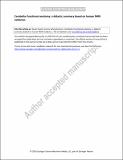Cerebellar Functional Anatomy: a Didactic Summary Based on Human fMRI Evidence
Author(s)
Guell Paradis, Xavier; Schmahmann, Jeremy
Download12311_2019_1083_ReferencePDF.pdf (784.1Kb)
Publisher Policy
Publisher Policy
Article is made available in accordance with the publisher's policy and may be subject to US copyright law. Please refer to the publisher's site for terms of use.
Terms of use
Metadata
Show full item recordAbstract
The cerebellum is relevant for virtually all aspects of behavior in health and disease. Cerebellar findings are common across all kinds of neuroimaging studies of brain function and dysfunction. A large and expanding body of literature mapping motor and non-motor functions in the healthy human cerebellar cortex using fMRI has served as a tool for interpreting these findings. For example, results of cerebellar atrophy in Alzheimer’s disease in caudal aspects of Crus I/II and medial lobule IX can be interpreted by consulting a large number of task, resting-state, and gradient-based reports that describe the functional characteristics of these specific aspects of the cerebellar cortex. Here, we provide a concise summary that outlines organizational principles observed consistently across these studies of normal cerebellar organization. This basic framework may be useful for investigators performing or reading experiments that require a functional interpretation of human cerebellar topography.
Date issued
2019-11Department
Massachusetts Institute of Technology. Department of Brain and Cognitive SciencesJournal
Cerebellum
Publisher
Springer US
Citation
Guell, Xavier and Jeremy Schmahmann. "Cerebellar Functional Anatomy: a Didactic Summary Based on Human fMRI Evidence." Cerebellum 19 (November 2019): 1-5 © 2019 Springer Science Business Media, LLC
Version: Author's final manuscript
ISSN
1473-4230
1473-4222